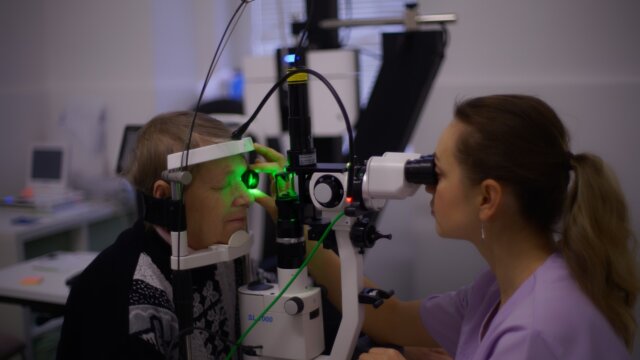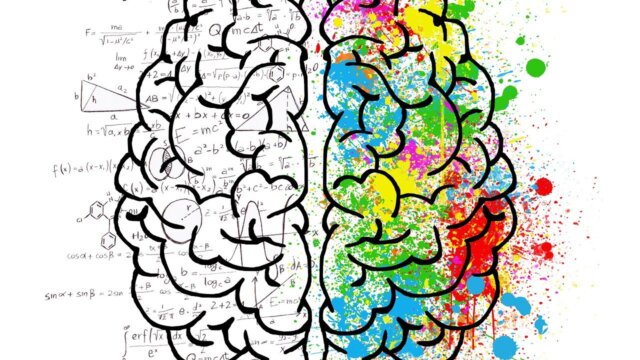FTC disclaimer: This post may contains affiliate links and we will be compensated if you click on a link and make a purchase.
There are 20 amino acids in your body that create proteins. These special parts play a big role in your health. They help muscles grow, brains work, and the body heal.
Amino acids come in three types: essential, nonessential, and conditionally essential. Your body needs the 9 essential amino acids but can’t make them. But, it can make the other 11 nonessential amino acids. Sometimes, amino acids like arginine and glutamine are needed a lot for your body’s health, like when you’re sick.
It’s important to get all types of amino acids for your health. They help build muscles, work your brain, and keep you well. We will tell you everything about amino acids, from what they do to where to find them in foods. Let’s start this exciting journey into the world of amino acids.
Key Takeaways
- Amino acids are the fundamental building blocks of proteins, which are essential for the structure and function of your body.
- There are 9 essential amino acids that your body cannot produce and must be obtained from your diet.
- Nonessential amino acids can be synthesized by your body, but they still play critical roles in various bodily processes.
- Conditionally essential amino acids become essential during times of illness, stress, or specific physiological states.
- Achieving a balanced intake of all amino acids, through a varied and protein-rich diet, is crucial for maintaining optimal health and well-being.
What are Amino Acids?
Amino acids are like Lego pieces for proteins and other important chemicals in our bodies. They have a special structure that includes an amino group and a carboxyl group. The special thing is, they all have the same basic parts but a different side chain makes each one unique. This uniqueness helps them do different jobs in our bodies.
The Building Blocks of Life
Proteins are very important for our bodies because they help build and repair. They are made from amino acids. Amino acids are the smallest parts of proteins but they are very powerful.
Molecular Structure of Amino Acids
The amino acid molecular structure is quite interesting. It has a central carbon with different parts attached. The parts include an amino group and a carboxyl group, plus a unique side chain. This composition is what makes one amino acid different from another.
Essential Amino Acids
There are 20 amino acids but only 9 are needed from food. These 9 include histidine, isoleucine, leucine, and others.
The Nine Essential Amino Acids
The body can’t make these essential amino acids alone. They help with making proteins, growing, and healing. Only 9 out of 20 amino acids are needed for our health. This includes valine, leucine, and isoleucine, which are special.
Why Essential Amino Acids are Crucial
Amino acids are vital for health because we can’t produce them naturally. They take part in digesting food, growing, and fixing our tissues. A good diet includes all types of amino acids daily.
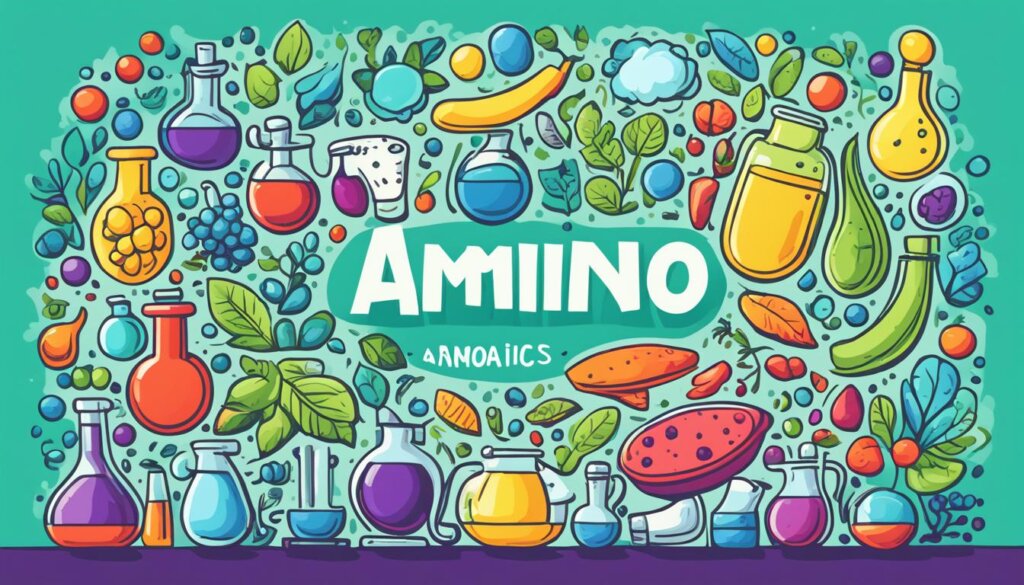
Nine specific amino acids are crucial for us and are found in food. These include histidine, isoleucine, leucine, and more. It’s essential to get enough of these amino acids to fulfill our protein needs.
A 60 kg person needs about 1,200 mg of isoleucine each day. For older adults recovering from knee surgery, Amino acid supplements might be helpful.
Nonessential Amino Acids
The nonessential amino acids are very important, though they can be made by your body. They are crucial for many parts of health and functioning. There are 11 of these amino acids, including alanine, arginine, and asparagine. These amino acids help with several key processes even though you don’t need to get them from your food.
Nonessential amino acids are key in making proteins, giving energy, and helping your immune system. They also control your brain’s mood messengers. They might not get as much talk as the essential amino acids do. But they are just as vital for your health and happiness.
On top of the 11 nonessential amino acids, there are 7 more that the body sometimes can’t make enough of. These include arginine and tyrosine. They are usually nonessential. But, they can be crucial at certain times, like when you’re sick or growing.

Knowing about nonessential amino acids helps us take in the right amounts for good health. It’s important to eat a balanced diet to get them. They are found in both plant and animal foods. These amino acids are vital for our life and health.
Conditionally Essential Amino Acids
There are essential and nonessential amino acids with clear roles. But, conditionally essential amino acids form a unique group. This group includes arginine, cysteine, glutamine, tyrosine, glycine, proline, and serine. They are not always essential but can be key in some situations.
When Are They Essential?
Conditionally essential amino acids are crucial when the body can’t make enough.This need arises during growth, pregnancy, illness, or injury recovery. For instance, the body might need extra arginine or glutamine under stress or due to trauma.
Knowing about conditionally essential amino acids is vital. They support the body’s functions and health, especially when it’s under stress.
By getting enough of these amino acids in your diet or through supplements, you can support your body. This is important for staying healthy in tough times.
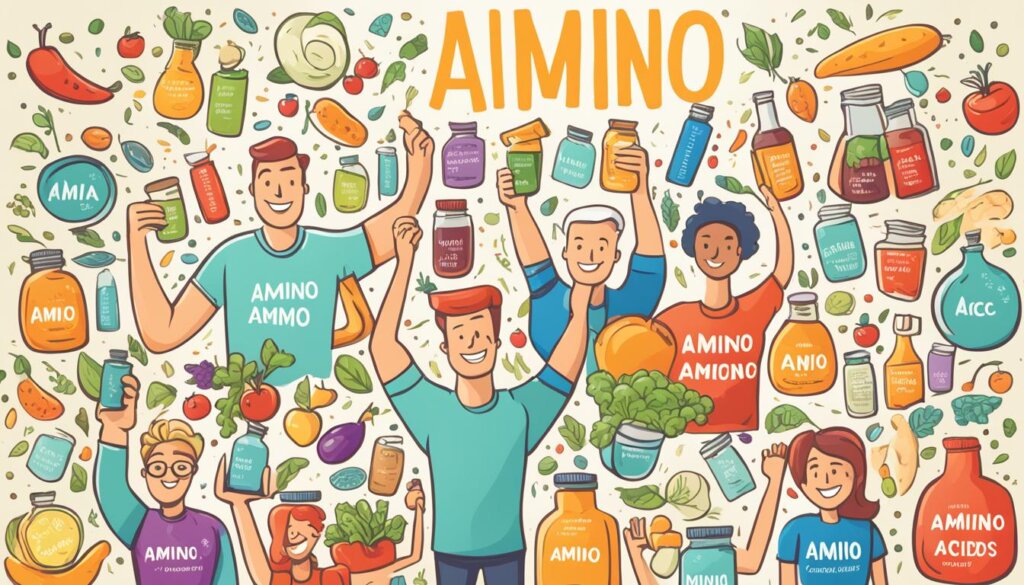
Functions of Amino Acids
Amino acids are very important in the body. They form proteins. These proteins are key for our tissues and organs. Amino acids also help make energy. They can change into carbohydrates or fuel our energy directly. Some amino acids create chemicals in the brain, like serotonin and dopamine, which help us think and feel well.
Protein Synthesis
Proteins are everywhere in our bodies. Amino acids make them up. The patterns of amino acids decide what a protein does. Proteins help with many body jobs, from fixing cells to fighting off germs.
Energy Production
Amino acids do more than build proteins. They convert into energy for us. They can turn into carbs or make ATP, our main energy form. This process helps keep our metabolism in shape and fuels our activities.
Neurotransmitter Synthesis
Some amino acids are the start of making brain chemicals. These chemicals, like serotonin and dopamine, control our feelings and thoughts. Getting enough of these amino acids is important for our mental health and good cognitive function.

Classification of Amino Acids
Amino acids come in three main types: essential, nonessential, and conditionally essential. There are 20 amino acids used to build proteins. These include alanine, arginine, asparagine, aspartic acid, cysteine, and more. Essential amino acids have to come from the food you eat. The body doesn’t make them. Nonessential amino acids can be made inside your body. Conditionally essential ones are important at certain times.
Sources of Amino Acids
You can get amino acids from many foods. These include meat, eggs, dairy, nuts, seeds, and certain plants. Foods like beef, poultry, and eggs are rich in all 9 essential amino acids. But, nuts, seeds, beans, and some grains don’t have all essential amino acids. Before taking amino acid supplements, check with a doctor. They aren’t FDA approved.
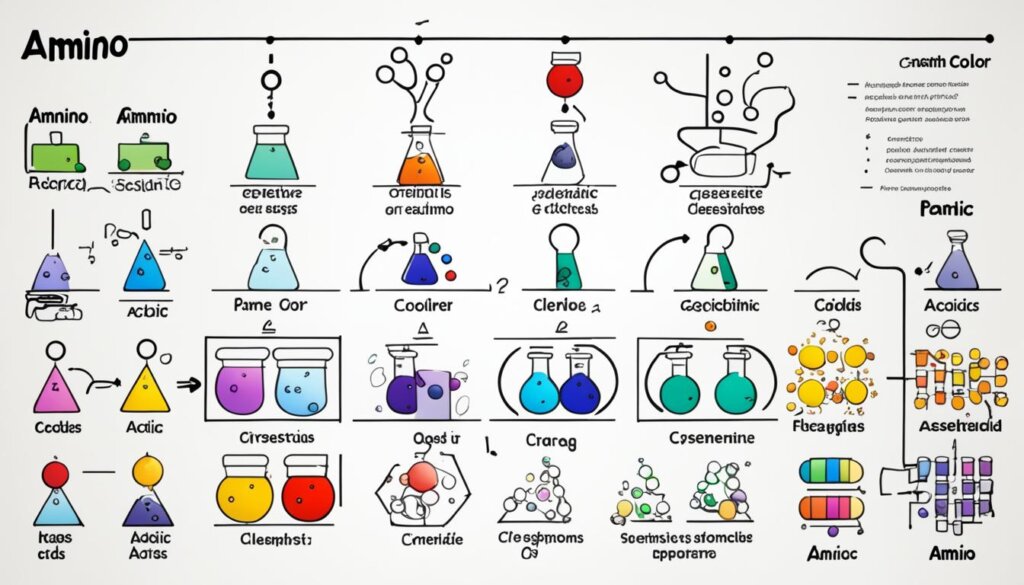
Amino Acid Metabolism
Amino acids are vital for our body’s energy needs. Animals must eat these amino acids as they can’t make the essential ones themselves. Some amino acids help make glucose, while others make ketone bodies.
Glucogenic Amino Acids
Several amino acids can turn into glucose for energy, like alanine and histidine. This process is called gluconeogenesis.
Ketogenic Amino Acids
Amino acids such as leucine and tryptophan can be turned into ketone bodies. These ketones are an energy source when carbs are low.
The body uses both types of amino acids for energy based on its needs. Glutamate helps move nitrogen between amino acids, and tyrosine makes hormones and neurotransmitters.
Cancer cells need amino acids to grow because they’re building blocks for many important molecules. Their metabolism includes complex actions like transamination.
Amino acids are key for cell growth and energy. They also help manage the immune system’s T cells.
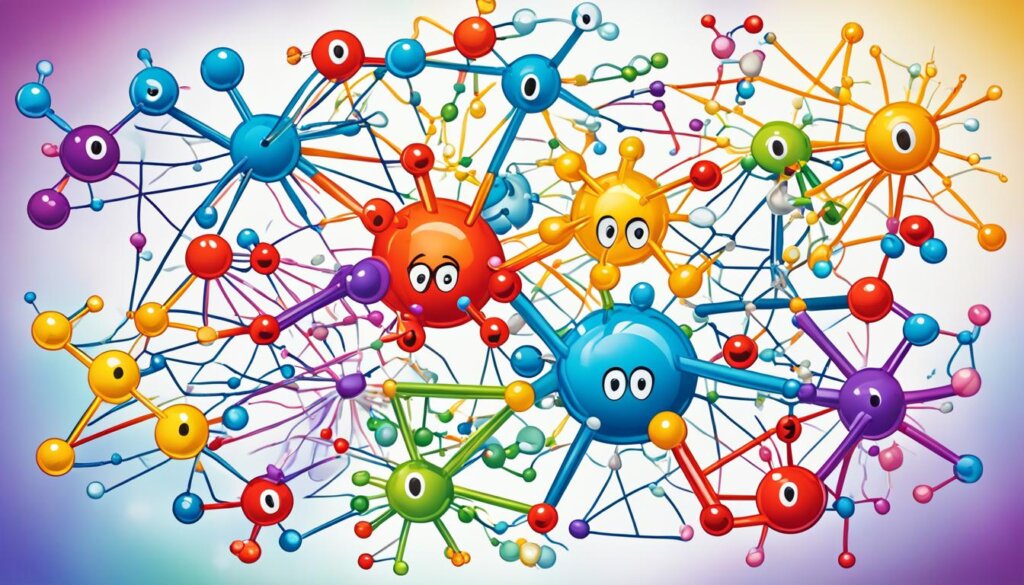
Amino Acid Synthesis
Humans need 20 amino acids for protein making. But, we can only make around half of these on our own. Mammals, including us, can make nonessential amino acids. But, we need to get essential amino acids from our food.
Not being able to make all amino acids might be an evolutionary benefit. It can save energy, especially in making more genetic material. It gives organisms a better chance at surviving. However, it makes them rely on getting some amino acids from other sources.
Biosynthesis Pathways
The process of making amino acids is complex. It needs different kinds of molecules and enzymes. Amino acids not essential in our diet are made from certain steps of metabolism. Essential amino acids come from what we eat.
The way each amino acid is made is not the same. But, some steps are similar for some amino acids. Knowing how this all works helps us understand how our body uses amino acids.
Amino Acid | Biosynthesis Pathway | Precursor Molecules |
|---|---|---|
Alanine | Glycolysis | Pyruvate |
Aspartate | Citric Acid Cycle | Oxaloacetate |
Glutamate | Citric Acid Cycle | Alpha-ketoglutarate |
Glycine | Serine Biosynthesis | Serine |
Proline | Glutamate Biosynthesis | Glutamate |
The making of amino acids is a detailed process. It’s how we and other organisms get what we need for life. Knowing about this helps in creating ways to improve health and fight disease.
Branched-Chain Amino Acids
Importance in Exercise and Muscle Growth
Branched-chain amino acids (BCAAs) are key for exercise and building muscle. They are used by muscles for quick energy when working out. BCAAs also help in making more proteins and stopping their breakdown. This helps muscles grow and heal.
Several studies prove BCAAs can boost how well you exercise, cut down tiredness in muscles, and aid in their repair and growth. Because of this, they are vital for people in sports, bodybuilding, and those who want to improve their fitness and muscle mass.
The way BCAAs are shaped lets them be used first by our muscles, avoiding the liver at first. This quick ‘route’ to effort muscle work stresses how important BCAAs are for training and muscle gain.
In short, BCAAs are super important for getting fit and growing muscles. Taking them from food or as extras is smart for better fitness, faster muscle healing, and growth.
Amino Acid Supplements
Amino acid supplements help boost your body’s amino acids or get a mix of necessary ones. They can help your muscles grow, recover, and make exercising better. These supplements might also help you sleep well, feel happier, and keep your body running smoothly.
Benefits and Risks
Yet, using amino acid supplements too much or the wrong way can be bad. It can lead to stomach problems, mix oddly with drugs, and even be harmful in big amounts. It’s smart to talk to a doctor before you begin any amino acid supplements. They can give advice on how to use them safely and talk about the good and bad points of using these supplements.
Popular Amino Acid Supplements
Some top amino acid supplements are branched-chain amino acids (BCAAs), whey protein (a rich amino acid source), L-arginine, L-glutamine, and creatine. These are made from amino acids. They can be good for certain body needs. But, remember, using them right and with expert advice is key.
Amino Acid Deficiencies
Amino acid deficiencies are serious and can cause many issues. Your body needs 21 amino acids but 9 are essential. We get these essential acids from what we eat. The rest, the body makes itself.
Symptoms and Causes
Tiredness, muscle loss, weak growth, and sickness can happen with amino acid shortages. Many things can cause these issues. Not eating well, parts of food not being absorbed right, or needing more nutrients during big life moments or health problems are common causes.
Some conditions, like PKU, change how amino acids work. PKU is most likely in the Turkish group. Another condition, Tyrosinemia, affects the use of tyrosine.
Prevention and Treatment
Eating a lot of protein from different sources is key to avoid these issues. Newborns are checked to catch problems early. They use a special test that shows if amino acids are off. This helps start care right away. Sometimes, extra amino acids might be needed. Always ask a doctor before taking any extra, to be safe.
Amino Acids in Food
Amino acids come from many foods, such as plants and animals. They help make protein, which is key for our cells.
Plant-Based Sources
Plants like legumes, nuts, and grains are good sources. They offer several amino acids we need. But, they don’t have all the essentials together, like nuts, beans, and grains. Quinoa, however, stands out. It has all nine essentials. Beans and such have lots of lysine and other must-have amino acids.
Animal-Based Sources
Meat, eggs, and dairy are rich in amino acids. They are full proteins, having all the key amino acids in the right ratios. Eggs are top-notch for fulfilling your essential amino acid needs. Tryptophan, found in turkey, helps make niacin and serotonin. Cottage cheese offers threonine and tryptophan for cells. Fish has essentials and Omega 3s, especially salmon.
Eating both plant and animal foods is great for getting all amino acids.
The Role of Amino Acids in Disease
Amino acids are key for staying healthy and keeping away diseases. Some diseases, like Alzheimer’s and Parkinson’s, happen when proteins fold the wrong way. Amino acids are also important for our metabolism, brain health, and fighting off sickness. Eating a mix of foods helps keep your amino acids in check, protecting your health.
Protein Misfolding Diseases
If proteins don’t fold right, we get big problems. These problems can hurt our cells and lead to diseases like Alzheimer’s. Knowing about amino acids can help researchers find new ways to treat these tough diseases.
Amino Acid Imbalances
Your body needs 20 amino acids but can make only 9 of them. Not having the right balance of these amino acids can harm our health in big ways. It can cause problems in our metabolism, brain, and how well our immune system works. It’s vital to eat a mix of foods to keep these building blocks in check.
Tryptophan supplements can make you feel better, less anxious, and happier. Supplements of valine, leucine, and isoleucine help with workouts, healing, and stopping tiredness. After surgery, taking these supplements can lower risks and help you heal better.
Remember, the best way to get essential amino acids is through your diet. You don’t usually need to worry about taking them separately because a good diet gives you what you need.
Knowing the power of amino acids helps us make smart choices for our health. Make sure your meals are full of variety to support a good balance of amino acids.
Emerging Research on Amino Acids
Ongoing research is finding new insights into amino acids. Scientists are looking into how amino acids can help in treating brain issues, boost sports ability, help the immune system, and more. We’re also finding new amino acids like selenocysteine and pyrrolysine, showing us there’s a lot we still don’t know about these essential life blocks.
Year | Study | Key Findings |
|---|---|---|
1984 | Annual Review of Nutrition | A study on branched-chain amino acid metabolism was published. |
1989 | Annals of Surgery | The addition of glutamine to total parenteral nutrition after elective abdominal surgery improved nitrogen balance. |
2011 | The American Journal of Gastroenterology | The effects of branched-chain amino acids supplementation in patients with cirrhosis and a previous episode of hepatic encephalopathy were examined. |
2012 | Gastroenterology | A practice guideline by the American Gastroenterological Association on the diagnosis and management of non-alcoholic fatty liver disease was provided. |
2013 | Applied Physiology, Nutrition and Metabolism | Branched-chain amino acids alleviate nonalcoholic steatohepatitis in rats. |
2013 | Clinical Nutrition | Leucine co-ingestion improves post-prandial muscle protein accretion in elderly men. |
2006 | Journals of Gerontology, Series A: Biological Sciences and Medical Sciences | The loss of skeletal muscle strength, mass, and quality in older adults was discussed. |
2013 | ISRN Nutrition | A branched-chain amino acid plus glucose supplement reduced exercise-induced delayed onset muscle soreness in college-age females. |
The ongoing emerging research on amino acids is showing us new things about their roles in our bodies. This work helps us know better how amino acids can improve health and performance. It’s not just about old amino acids; we keep finding new ones. This growing knowledge is key for using amino acids to better our life and well-being.
Conclusion
Amino acids are very important. They are the basic parts of proteins. Every protein you have is made from 20 different amino acids. These proteins are needed for your body to work right. Some amino acids your body can make. Others you need to get from food. Knowing about these amino acids and where they come from is vital for your health. It helps your body do many things.
Scientists are still learning a lot about amino acids. As they do, we find new ways to stay healthy. Adding foods rich in amino acids to your diet can be really good for you. This is especially true if you want to build muscle, do better in sports, or keep your body in good shape.
So, amino acids are the key to life. Eating the right foods with them is very important. It helps you use your body’s potential fully. This makes your future health bright and strong.
FAQ
What are amino acids?
Amino acids are like building blocks for proteins. They also help create things like neurotransmitters and hormones. These compounds have an amino group (-NH2) and a carboxylic acid group (-COOH).
What are the different types of amino acids?
There are three types of amino acids. Essential ones are needed from food because our bodies can’t make them. Nonessential amino acids are made by our bodies. Then, conditionally essential ones are needed sometimes, like when we’re sick.
What are the functions of amino acids in the body?
Amino acids are key for protein building, making energy, and helping with our mood and sleep. They form proteins that keep our body’s tissues and organs working right.
How can I get amino acids from my diet?
You can get amino acids from both plant and animal foods. Plants like legumes, nuts, seeds, and whole grains are good sources. Animal foods, including meat, fish, eggs, and dairy, also provide amino acids.
What are the benefits and risks of amino acid supplements?
Supplements can help with muscle growth, better exercise, and mood. But, taking too much or not needed can cause problems. This can lead to digestive issues and might not mix well with some medications.
What are the symptoms and causes of amino acid deficiencies?
Not getting enough amino acids can make you feel tired and look weak. It can slow your growth, lower your immunity, and mess with your organs. Bad diet, trouble absorbing nutrients, higher needs due to health issues, or genetic problems can cause these shortages.
How do amino acids play a role in disease?
Too many or too few amino acids can lead to health problems. This includes issues with proteins, metabolism, nerves, and the immune system. Eating a balanced diet helps prevent these health issues.
What are the latest advancements in amino acid research?
New studies are finding out more about amino acids in our bodies. ^Expert researchers are looking into how certain amino acids can help with sickness, sports, and keeping us healthy.





